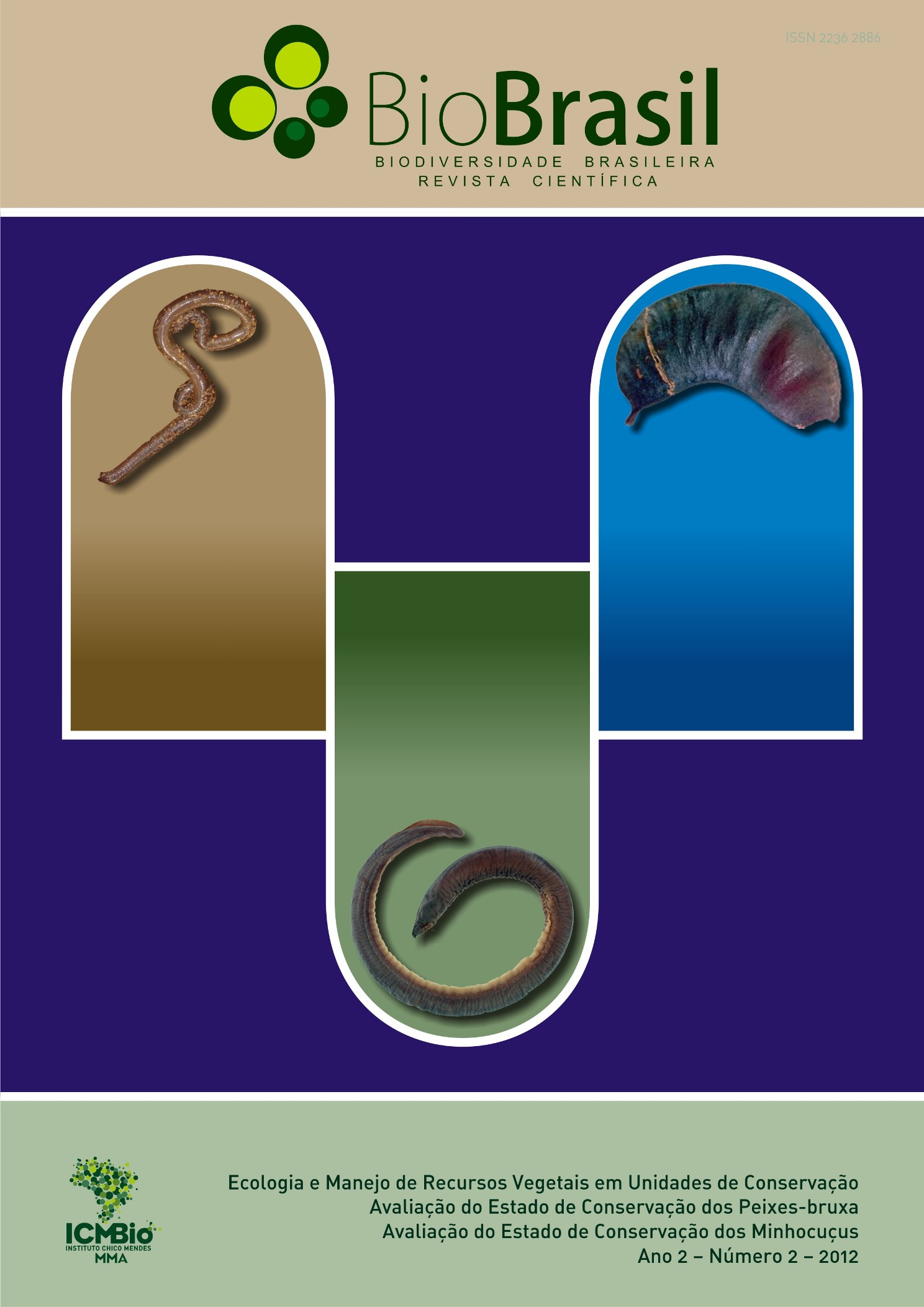Empoderamento de comunidades rurais e o estabelecimento de uma Reserva de Desenvolvimento Sustentável: Estudo de caso nos Areais da Ribanceira, Imbituba – SC
DOI:
https://doi.org/10.37002/biodiversidadebrasileira.v2i2.272Keywords:
community biodiversity management, empowerment, in situ conservation, plant resources, protected areasAbstract
– In this study our objective was to analyze the empowerment of the community Areais
da Ribanceira, in the municipality of Imbituba (Santa Catarina, Brazil). People from this community
are engaged in a struggle for the recognition to maintain the traditional livelihood and for the establishment
of a Sustainable Development Reserve, a protected area of sustainable use. Studies of empowerment in
the context of protected area management collaborate to establish a kind of biodiversity conservation that
actually allows the inclusion and involvement of local communities in the conservation process. Data were
collected through interviews with members of household units, local leaders and external stakeholders,
and through workshops and use of participatory research tools with the community and local leaders.
The empowerment of the community of Areais da Ribanceira is more developed in the social domain, as
compared to the legal and economic domains. The threat of losing its territory was the main motivation that
allowed the organization of the community, and several community management activities contributed to
the local empowerment. The organization and mobilization of the community of Areais da Ribanceira are
factors that facilitate the process of creating a Sustainable Development Reserve
References
De Boef, W.S.; Thijssen, M.H. & Verhoosel, K.S. 2013. Community biodiversity management and empowerment. In: De Boef, W.S.; Peroni, N.; Subedi, A.; Thijssen, M.H. & O’Keeffe, E. (eds). Community biodiversity management: promoting resilience and the conservation of plant genetic resources. London, Earthscan (in press).
De Boef, W.S.; Thijssen, M.H.; Shrestha, P.; Subedi, A.; Feyissa, R.; Gezu, G.; Canci, A.; Fonseca Ferreira, M.A.J. da; Dias, T.; Swain S. & Sthapit B.R. 2012. Moving beyond the dilemma: practices that contribute to the on-farm management of agrobiodiversity. Journal of Sustainable Agriculture, 36: 788–809.
Dressler, W.; Büscher, B.; Schoon, M.; Brockington, D.; Hayes, T.; Kull, C.A.; McCarthy, J. & Shrestha, K. 2010. From hope to crisis and back again? A critical history of the global CBNRM narrative. Environmental Conservation, 37, p. 5-15.
Eyben, R.; Kabeer, N. & Cornwall, A. 2008. Conceptualising empowerment and the implications for pro poor growth: A paper for the DAC Poverty Network. Institute of Development Studies. 37p. http://www.gsdrc.org/docs/open/SE8.pdf (Acesso em 29 setembro 2012).
Fabiano, R.B. 2007. Relatório técnico socioeconômico e fundiário para a criação de unidade de conservação na região da Lagoa de Ibiraquera / Santa Catarina. Projeto Mata Atlântica FAO/GCP/ BRA/061/WBK.
Fabiano, R.B. 2008. Relatório socioeconômico para a criação da reserva de desenvolvimento sustentável nos areais da ribanceira, no município de Imbituba/SC. Projeto Mata Atlântica FAO/ GCP/BRA/061/WBK.
Freire, P. 1986. Educação como prática para a liberdade. 17a, ed., Rio de Janeiro: Paz e Terra. 192p.
Freire, P. 1988. Pedagogia do oprimido. 18a, ed. Rio de Janeiro: Paz e Terra. 256p.
Gaventa, J. & Cornwall, A. 2006. Challenging the Boundaries of the Possible: Participation, Knowledge and Power. Institute of Development Studies (IDS Bulletin), 37 (6): 122-128.
IBGE, 2010. Contagem da População. http://www.ibge.gov.br. (Acessado em 14/04/2012).
Kabeer, N. 1999. Resources, Agency, Achievements: Reflections on the Measurement of Women’s Empowerment. Development and Change, 30(3): 435-464.
Lutrell, C.; Quiroz, S. Scrutton, C. & Bird, K. 2007. Understanding and operationalising empowerment. Poverty-Wellbeing.net. The platform on livehoods equity and empowerment. Swiss Agency for development and Cooperation. Oakley, P. & Clayton, A. 2000. The monitoring and evaluation of empowerment. A Resource Document. Occasional Papers Series 26.
Pinto, M. F. 2010. Manejo local de agrobiodiversidade: conservação e geração de diversidade de mandioca (Manihot esculenta Crantz.) por agricultores tradicionais dos Areias da Ribanceira, Imbituba- SC. Trabalho de conclusão de curso. Universidade Federal de Santa Catarina, Florianópolis, SC.
Sampaio, L.K. 2011. Etnobotânica e estrutura populacional do butiá, Butia catarinensis Noblick & Lorenzi (Arecaceae) na comunidade dos Areais da Ribanceira de Imbituba/SC. Dissertação (mestrado). Programa de Pós-graduação em Biologia Vegetal, Universidade Federal de Santa Catarina, Florianópolis, SC.
Shrestha, P.; Subedi, A.; Sthapit, B.R. & De Boef, W.S., 2013. Community biodiversity management: defined and contextualized. In: De Boef, W.S., Peroni, N., Subedi, A., Thijssen, M.H. e O’Keeffe, E. (eds.). Community biodiversity management: promoting resilience and the conservation of plant genetic resources . London, Earthscan (in press).
Sistema Nacional de Unidades de Conservação da Natureza – SNUC: lei n. 9.985, de 18 de julho de 2000; decreto n. 4.340, de 22 de agosto de 2002. 4ª Edição. Brasília: MMA/SBF.
Sthapit, B.; Subedi, A. & Gautam, R. 2007. Ferramentas práticas que estimulam o manejo comunitário da agrobiodiversidade. Manejo Comunitário da Agrobiodiversidade. In: De Boef, W.S.; Thijssen, M.H.; Ogliari, J.B. & Sthapit, B.R. (ed). Biodiversidade e agricultores: fortalecendo o manejo comunitário. Porto Alegre, RS: L&PM, p.136-156.
Thijssen, M.H.; De Boef W.S. & Borman, G. (eds), 2012. Community biodiversity management and empowerment: documentation of the sites included in a global study, Wageningen: Wageningen UR/CDI.http://www.cdi.wur.nl/NR/rdonlyres/8A95C897-C42C-4A57-9DDB-5EECFF725066/157075/ FullTextlight.pdf.(Acesso em 14/04/2012)
WWF-Brasil. 2007. Reserva de desenvolvimento sustentável: diretrizes para a regulamentação. Brasília.
Zank, S.; Assis, A.L.; Borges, M.; Peroni, N. & Hanazaki, N. 2013. The sustainable development reserve: an option for securing livelihoods in Imbituba, Brazil. In: De Boef, W.S., Peroni, N., Subedi, A., Thijssen, M.H. e O’Keeffe, E. (eds.). Community biodiversity management: promoting resilience and the conservation of plant genetic resources. London, Earthscan (in press).
Downloads
Published
Issue
Section
License
Copyright (c) 2012 Os autores mantêm os direitos autorais de seus artigos sem restrições, concedendo ao editor direitos de publicação não exclusivos.

This work is licensed under a Creative Commons Attribution-NonCommercial-NoDerivatives 4.0 International License.
Os artigos estão licenciados sob uma licença Creative Commons Atribuição-NãoComercial-SemDerivações 4.0 Internacional (CC BY-NC-ND 4.0). O acesso é livre e gratuito para download e leitura, ou seja, é permitido copiar e redistribuir o material em qualquer mídia ou formato.





 v3-3-0-3-2-1-8-release.27
v3-3-0-3-2-1-8-release.27